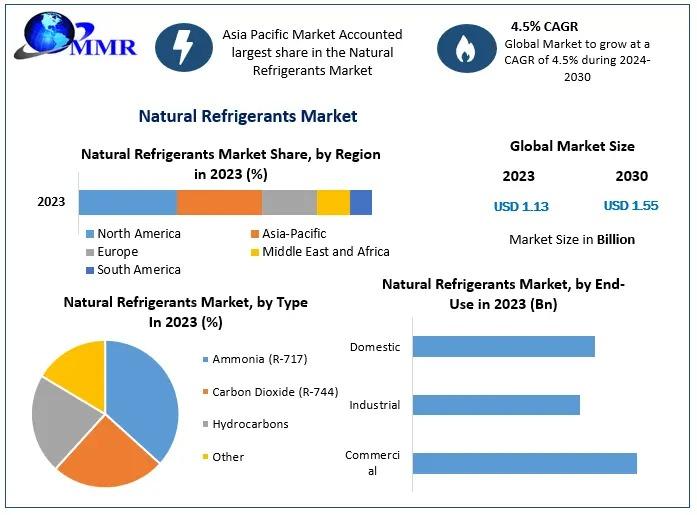
Sustainability in Focus: What’s Next for the Material Industry?
The Natural Refrigerants Market is poised for significant growth, with projections indicating an increase from USD 1.13 billion in 2023 to USD 1.55 billion by 2030. This growth, at a compound annual growth rate (CAGR) of 4.5%, is fueled by rising environmental concerns, stringent regulations on synthetic refrigerants, and advancements in refrigeration technologies.
Market Estimation & Definition
Natural refrigerants are substances that occur naturally in the environment and are used as cooling agents in refrigeration and air conditioning systems. Unlike synthetic refrigerants, natural refrigerants such as ammonia (R-717), carbon dioxide (CO₂, R-744), and hydrocarbons like propane (R-290) and isobutane (R-600a) have minimal or zero global warming potential (GWP) and ozone depletion potential (ODP). Their adoption is increasingly favored due to environmental sustainability and compliance with international regulations.
Ask for Sample to Know US Tariff Impacts on Natural Refrigerants Market @ Sample Link :https://www.maximizemarketresearch.com/request-sample/118102/
Market Growth Drivers & Opportunities
- Environmental Regulations: Global initiatives and regulations aimed at reducing greenhouse gas emissions are prompting industries to transition from synthetic to natural refrigerants.
- Energy Efficiency: Natural refrigerants often offer superior thermodynamic properties, leading to enhanced energy efficiency and reduced operational costs.
- Technological Advancements: Innovations in refrigeration technology are facilitating the safe and efficient use of natural refrigerants across various applications.
- Consumer Awareness: Growing consumer awareness regarding environmental issues is increasing demand for eco-friendly refrigeration solutions.
Segmentation Analysis
By Type:
- Ammonia (R-717): Widely used in industrial refrigeration due to its high energy efficiency and low environmental impact.
- Carbon Dioxide (CO₂, R-744): Preferred for commercial refrigeration applications, including supermarkets and vending machines, owing to its non-flammable nature and excellent heat transfer properties.
- Hydrocarbons: Propane (R-290), isobutane (R-600a), and propylene (R-1270) are commonly used in domestic refrigeration and small commercial systems due to their high efficiency and low environmental impact.
By Application:
- Commercial Refrigeration: Includes supermarkets, convenience stores, and food service industries where natural refrigerants are increasingly adopted.
- Industrial Refrigeration: Encompasses cold storage, food processing, and chemical industries utilizing ammonia and CO₂ for large-scale cooling needs.
- Domestic Refrigeration: Household refrigerators and freezers are gradually transitioning to hydrocarbon-based refrigerants for improved energy efficiency.
- Stationary Air Conditioning: Natural refrigerants are being explored for residential and commercial air conditioning systems.
- Mobile Air Conditioning: Automotive air conditioning systems are beginning to incorporate natural refrigerants, though adoption is currently limited.
Country-Level Analysis
United States:
The U.S. market is witnessing a gradual shift towards natural refrigerants, driven by environmental regulations and corporate sustainability goals. While adoption is currently more prominent in industrial and commercial sectors, residential applications are expected to grow as technology advances and awareness increases.
Germany:
Germany leads in the adoption of natural refrigerants within Europe, supported by stringent environmental policies and a strong emphasis on energy efficiency. The country's robust industrial base and commitment to sustainable practices are key factors propelling market growth.
Ask for Sample to Know US Tariff Impacts on Natural Refrigerants Market @ Sample Link :https://www.maximizemarketresearch.com/request-sample/118102/
Competitive Landscape
The natural refrigerants market is characterized by the presence of several key players focusing on innovation, strategic partnerships, and expansion to strengthen their market position. Notable companies include:
- Linde Group: A leading provider of industrial gases, including natural refrigerants, with a strong global presence.
- Airgas Inc.: Offers a comprehensive range of refrigerant gases, emphasizing environmentally friendly solutions.
- A-Gas International: Specializes in the supply and lifecycle management of refrigerants and associated products.
- Sinochem: A major Chinese chemical company involved in the production and distribution of refrigerants.
- Johnson Controls, Inc.: Provides HVAC systems and controls, integrating natural refrigerants into their product offerings.
Conclusion
The global natural refrigerants market is on an upward trajectory, driven by environmental imperatives, regulatory frameworks, and technological advancements. As industries and consumers increasingly prioritize sustainability, the demand for natural refrigerants is expected to rise, offering significant opportunities for market players to innovate and expand.
Explore Related Reports by Maximize Market Research :
Global Liquid Polybutadiene Market https://www.maximizemarketresearch.com/market-report/global-liquid-polybutadiene-market/70783/
Textile Coatings Market https://www.maximizemarketresearch.com/market-report/textile-coatings-market/11890/
About Maximize Market Research:
Maximize Market Research is one of the fastest-growing market research and business consulting firms serving clients globally. Our revenue impact and focused growth-driven research initiatives make us a proud partner of majority of the Fortune 500 companies. We have a diversified portfolio and serve a variety of industries such as IT & telecom, chemical, food & beverage, aerospace & defense, healthcare and others.
Contact Maximize Market Research:
MAXIMIZE MARKET RESEARCH PVT. LTD.
⮝ 3rd Floor, Navale IT park Phase 2,
Pune Banglore Highway, Narhe
Pune, Maharashtra 411041, India.
✆ +91 9607365656
🖂 sales@maximizemarketresearch.com

